The signal is today one of the most common parts of our lives. We use wireless data transmission to make phone calls, listen to the radio, watch television or connect to the internet. Information is now available more than ever before. All this is thanks to advances in radio communications and antenna development. Today, antennas as such are all around us. They are so frequent that we do not even notice them anymore. We can find them on buildings, in mobile phones, smart watches, etc. SECTRON has a large enough portfolio to be able to assist in the field of radiocommunication. From small flexible antennas such as the FPC-14 antenna that is used in M2M devices, over antennas for free bands like 868 MHz, to special Trimble GPS antennas and many more.
But how do you choose the right antenna? There are directional antennas, such as the LTE Yagi 140 antenna, which sends and receives only in a certain direction, thus ensuring a more reliable connection at a greater distance. Such antennas can not be moved without the need for their subsequent realignment. We often see this type on the buildings around us. Another type is the omnidirectional antenna, most commonly found on devices that can be easily moved. These antennas are found, for example, in mobile phones, as part of terminals, laptops, trains, etc. A good example of this type can be a simple LTE PUK that you can notice on some cars.
As already hinted above, different types of antennas are required for different types of signals. If you happen to want to connect to a GSM mobile network and you are in a place with a bad signal, simply plug in your device GSM/UMTS Magnetic 90 antenna with a gain of 9 dBi, attach its magnetic base to a metal surface and your problem will most likely be resolved. To receive a WiFi signal, use an antenna such as the WiFi Stick. 2.4 GHz. 5 dBi. RP-SMA. Antennas exist in many different sizes and types of attachment. They can be mounting antennas, magnetic, adhesive, soldering or screwed, where the whole antenna is basically just a small plastic mold with a screw at one end. These antennas can often be seen on your terminal.
Terminals, or in other words modems or routers, are another important part of the radiocommunication field. They often use these technologies for receiving and transmitting information. This allows us to access the Internet in badly accessible locations, use M2M communications, connect smart devices to the cloud for IoT, or wirelessly collect data from many different places at once. In addition to its own terminals, SECTRON also offers products from its global partners such as Gemalto, Robustel, Advantech and many others. In essence, every idea that involves wireless communication is most likely to contain a terminal as an essential element in its infrastructure.
The choice of antennas or terminals may still be confusing due to their large number and seemingly small differences. However, if one has a certain vision, it is always possible to consult with the proven professionals in the field. For more than 20 years, SECTRON has proven its customer service to be of highest quality. It employs many professionals who know what antenna or terminal to choose to exactly suit your needs. If you already own one of these things, you may be able to address them with any concern, whether it is a problem with device installation, configuration, development, or any other issues related to this area.













